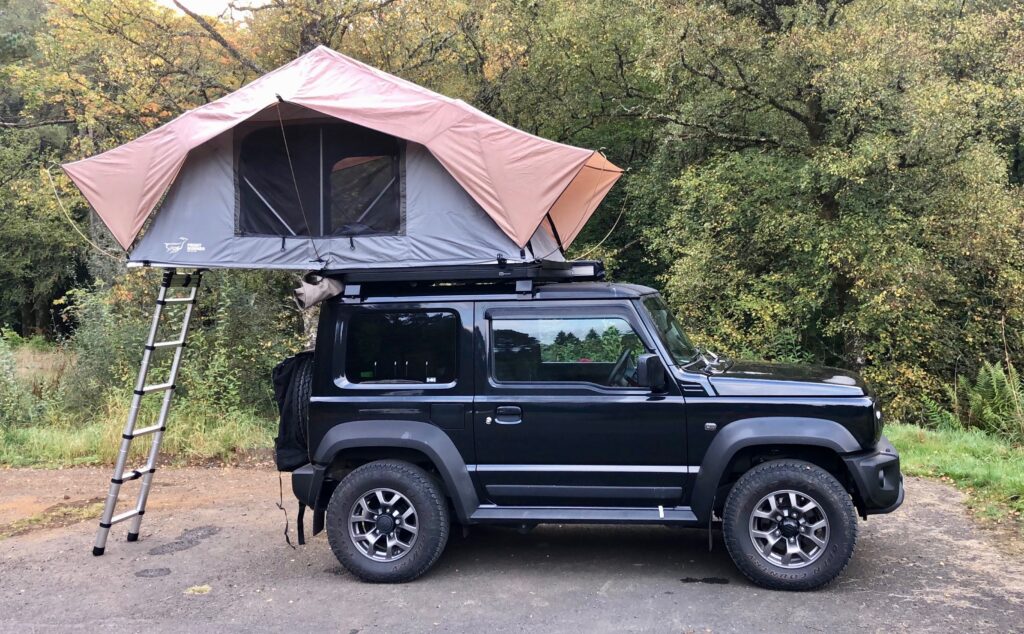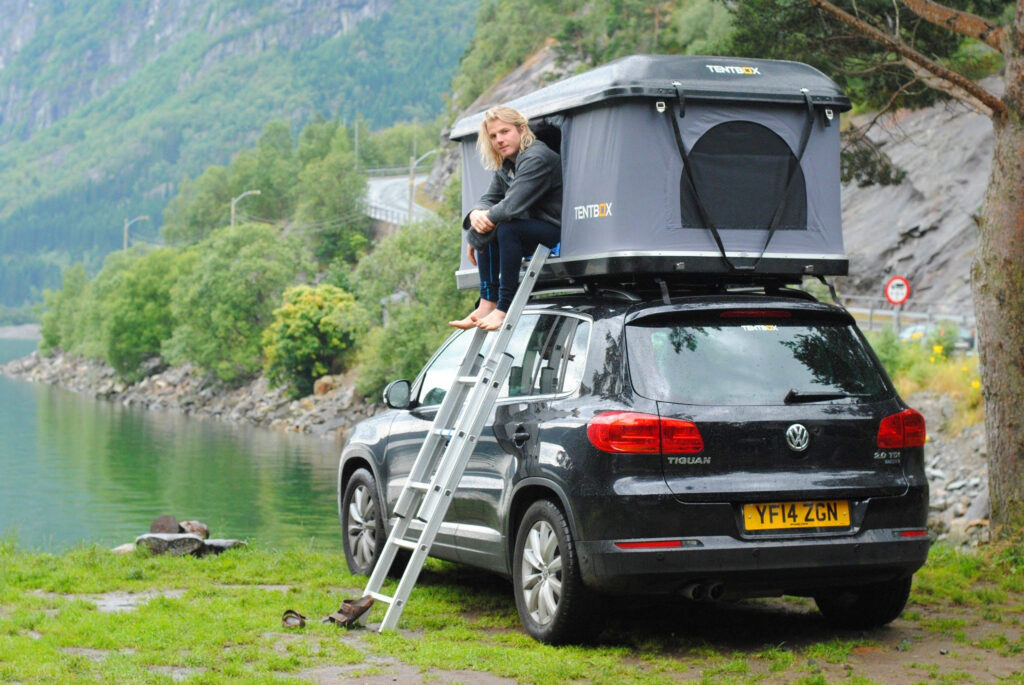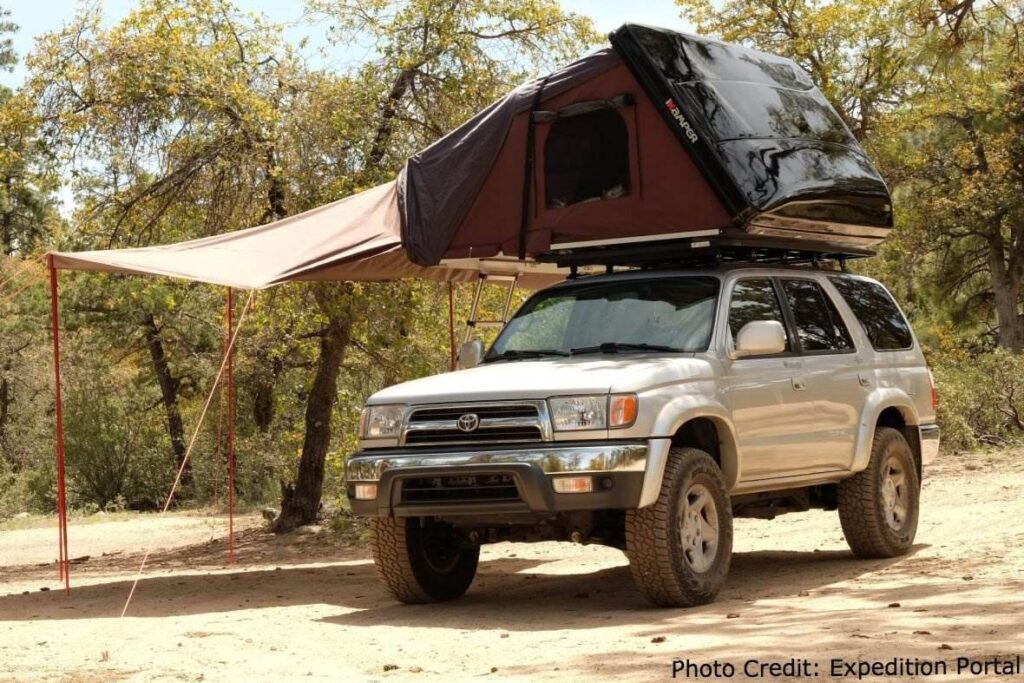Having an overhang on a mounted rooftop tent is allowed, provided the car is parked. However, the rooftop tent with the added weight of the overhang should not exceed the manufacturer’s recommended maximum rooftop weight of your vehicle. The amount of overhang depends on the roof rack, the type of rooftop tent, and the type of vehicle you mount. Different cars have different permissible rooftop weights.
To find out your vehicle’s maximum rooftop weight, consult your vehicle’s manufacturer manual. Regarding the type of rooftop tent, soft shell tents often have a more significant overhang when mounted compared to hard shell rooftop tents. This is due to the added floor space provided by the annex. You can pin the overhang edges to the ground to prevent excessive flapping in the wind.
The overhang can be as large as the size of the car, provided the roof rack is suitable for that particular weight. In contrast, hard-shell rooftop tents have less overhang. This is because hard shell roof tents extend upwards and not sideways like soft shell roof top tents. Essentially, the overhang is allowed on a mounted rooftop tent when the car is stationary, and the amount of overhang is primarily determined by the type of rooftop tent.
Table of Contents
Can a collapsed rooftop tent be wider than your vehicle?
Yes, a collapsed rooftop tent can be wider than your vehicle. In the US, the maximum permissible overhang is 3.9 inches (10cm) on each side. However, it is recommended that the collapsed roof tent should not be wider than your vehicle. Instead, the maximum width of your rooftop tent should be equal to the width of your car when the side mirrors are folded. This will allow better weight distribution over the roof racks, increasing their service length.
Can a rooftop tent protrude over the end of the vehicle when folded?
Yes, a collapsed rooftop tent can be longer than your vehicle. The rooftop tent is referred to as an overhanging load when it exceeds the length of your car. There are various rules in place to warn other drivers of the overhung load, such as tying a reflective material on the end of the load. According to the US department of transportation, the maximum overhang for any load is four feet (121 cm) from the car’s rear end. Nevertheless, rooftop tent experts recommend that the length of the rooftop tent should not exceed the rear bumper of your vehicle. This improves the stability of the rooftop tent and reduces the strain imposed on the roof racks, thus increasing their durability. Moreover, most roof racks only support a small amount of overhang, from 11.8inches to 19.6 inches. Adding extra roof rack support for any overhang is recommended, such as welding additional support bars to distribute the weight more evenly, thus avoiding damaging the roof racks.
Can I legally drive with a rooftop tent overhang on the street or highway?
You can drive with a rear or side overhang of your rooftop tent, provided it does not exceed the state’s permissible limits. Moreover, the rooftop tent should be securely tied down to prevent accidents on the street or highway. It is best not to exceed speeds of 65mph when driving a vehicle with an installed rooftop tent. This is due to the added tent and racks weight to your vehicle’s weight. Essentially, the extra weight affects your vehicle’s suspension, fuel consumption, acceleration, and power. To get more information, you can consult your vehicle’s manufacturer, rooftop tent manufacturer, and rooftop rack manufacturer to determine the maximum speed you can drive your vehicle and the expected changes due to the rooftop tent installation.
Which is the best rooftop tent option for my vehicle?
Various tent options are available depending on your vehicle size, the number of tent occupants, financial capability, and personal preference. Softshell roof tents offer more space, are affordable, and are made of lighter material. The disadvantages include time-consuming installation, bulky packaging, and increased noise during storms due to the soft outer shell. In contrast, hard-shell rooftop tents cancel outside noise, have easier installation, are more aerodynamic when collapsed, and take up less space on top of your vehicle. However, the downsides of hard shell tents are less space and more expensive to purchase.
Closing thoughts
Deciding to install a rooftop tent on your vehicle can be pretty intimidating. This decision requires proper research and expert consultation to determine your vehicle’s best roof rack and roof tent options. Failure to do this can result in you incurring significant financial losses and time wasted. Moreover, understanding the specifics of a rooftop tent, such as overhang length and driving speed, will enable you to work within the confines of the law and increase your overall safety. We hope this article will significantly benefit you as you prepare to purchase your rooftop tent.







